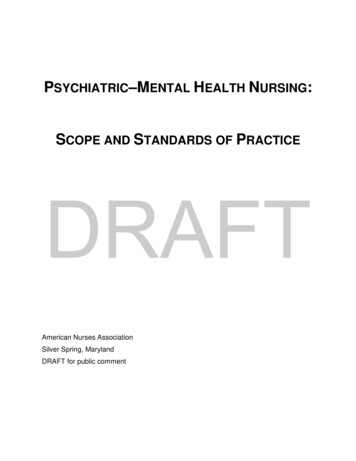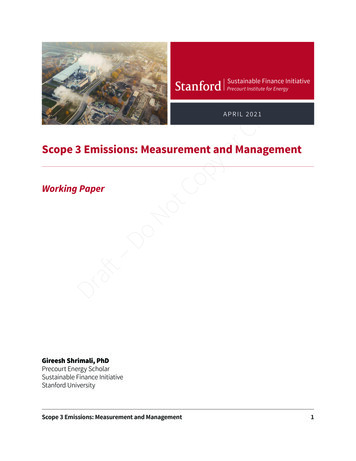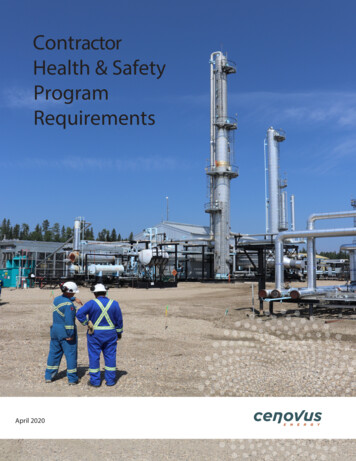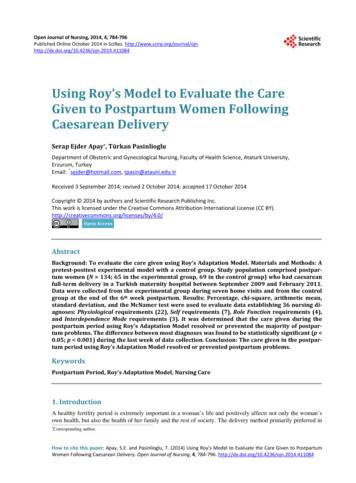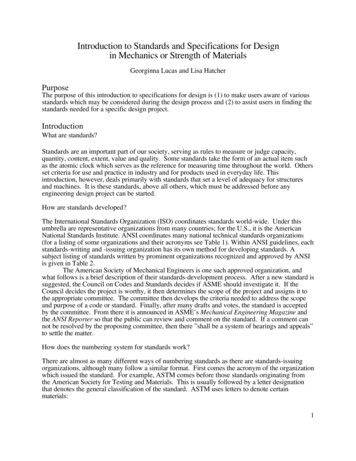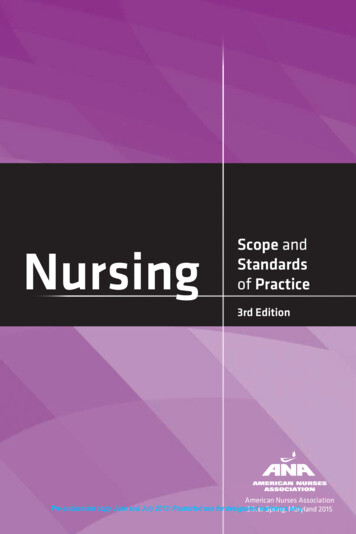
Transcription
NursingScope andStandardsof Practice3rd EditionAmerican Nurses AssociationPre-publication copy June and July 2013: Restricted use for designatedreviewersonly.SilverSpring, Maryland2015
The American Nurses Association (ANA) is a national professional association. ThisANA publication, Nursing: Scope and Standards of Practice, Third Edition, reflectsthe thinking of the nursing profession on various issues and should be reviewedin conjunction with state board of nursing policies and practices. State law, rules,and regulations govern the practice of nursing, while Nursing: Scope and Standardsof Practice, Third Edition, guides nurses in the application of their professionalknowledge, skills, and responsibilities.American Nurses Association8515 Georgia Avenue, Suite 400Silver Spring, MD gPublished by Nursesbooks.orgThe Publishing Program of ANAhttp://www.Nursesbooks.orgCopyright 2015 American Nurses Association. All rights reserved. Reproduction ortransmission in any form is not permitted without written permission of the AmericanNurses Association (ANA). This publication may not be translated without writtenpermission of ANA. For inquiries, or to report unauthorized use, email copyright@ana.org.Cataloging-in-Publication Data on file with the Library of CongressISBN-13: 978-1-55810-619-2SAN: 851-348107/2015First printing: July 2015Pre-publication copy June and July 2013: Restricted use for designated reviewers only.
ContentsContributorsviiOverview of the ContentxiEssential Documents of Professional NursingAdditional ContentAudience for This PublicationxixixiiScope of Nursing Practice1Definition of NursingProfessional Nursing’s Scope and Standards of PracticeDescription of the Scope of Nursing PracticeDevelopment and Function of the Standards of Professional Nursing PracticeStandards of PracticeStandards of Professional PerformanceThe Function of Competencies in StandardsIntegrating the Art and Science of NursingThe What and How of NursingTenets Characteristic of Nursing PracticeThe How of NursingThe Art of NursingThe Science of NursingWhen Nursing OccursNursing Knowledge, Research, and Evidence-based PracticeThe Where of Nursing PracticeHealthy Work Environments for Nursing PracticeSafe Patient Handling and Mobility (SPHM)Fatigue in Nursing PracticeWorkplace Violence and IncivilityOptimal StaffingSupports for Healthy Work EnvironmentsHigh-Performing Interprofessional TeamsKey Influences on the Quality and Environment of Nursing ublication copy June and July 2013: Restricted use for designated reviewers only.Contents Nursing: Scope and Standards of Practice, 3rd Ed. iii
Societal, Cultural, and Ethical Dimensions Describe the Why and How of NursingModel of Professional Nursing Practice RegulationThe Code of Ethics for NursesSpecialty Practice in NursingProfessional Registered Nurses Today: The Who of NursingStatistical SnapshotLicensure and Education of Registered NursesAdvanced Practice Registered Nurse RolesProfessional Competence in Nursing PracticeEvaluating CompetenceProfessional Trends and IssuesCreating a Sustainable Nursing WorkforceNursing EducationTechnological AdvancesPopulation Focus: Redefining Health and Well-being for theMillennial GenerationBaby Boomers: Health and Chronic IllnessSummary of the Scope of Nursing Practice3133363738384142434545464748Standards of Professional Nursing Practice51Significance of Standards51Standards of Practice53Standard 1. AssessmentStandard 2. DiagnosisStandard 3. Outcomes IdentificationStandard 4. PlanningStandard 5. ImplementationStandard 5A. Coordination of CareStandard 5B. Health Teaching and Health PromotionStandard 6. Evaluation5355575961636566Standards of Professional Performance67Standard 7. EthicsStandard 8. Culturally Congruent PracticeStandard 9. CommunicationStandard 10. CollaborationStandard 11. LeadershipStandard 12. EducationStandard 13. Evidence-based Practice and ResearchStandard 14. Quality of PracticeStandard 15. Professional Practice EvaluationStandard 16. Resource UtilizationStandard 17. Environmental Health6769717375767779818284484849Pre-publication copy June and July 2013: Restricted use for designated reviewers only.iv Nursing: Scope and Standards of Practice, 3rd Ed. Contents
Glossary85References and Bibliography91Appendix A: Nursing: Scope and Standards of Practice, 2nd Edition (2010)99Appendix B: Nursing’s Social Policy Statement: The Essence of the Profession (2010) 175Appendix C: ANA Position Statement: Professional Role Competence (2014)Appendix D: The Development of Essential Nursing Documents213and Professional Nursing223Appendix E: Selected Nurse Theorists227Appendix F: Culturally Congruent Practice Resources229Index235Pre-publication copy June and July 2013: Restricted use for designated reviewers only.Contents Nursing: Scope and Standards of Practice, 3rd Ed. v
Pre-publication copy June and July 2013: Restricted use for designated reviewers only.
ContributorsNursing: Scope and Standards of Practice, Third Edition, is the product of extensive thought work by many registered nurses and a three-step review process.This document originated from the decisions garnered during a significantnumber of telephone conference calls and electronic mail communications ofthe diverse workgroup members and an intensive two-day in person weekend meeting. The first review process, a 30-day public comment period, followed. All workgroup members reviewed every comment, resulting in furtherworkgroup refinements of the draft document. The official American NursesAssociation (ANA) review process included evaluation by the Committee onNursing Practice Standards and final review and approval by the ANA Boardof Directors in June 2015. The list of endorsing organizations that completesthis section reflects the broad acceptance of this resource within the profession.Nursing Scope and Standards Workgroup, 2014–2015Elizabeth Thomas, MEd, RN, NCSN, FNASN, ChairpersonChad Allen, RNSheri-Lynne Almeida, DrPH, MSN, MED, RN, CEN, FAENCarolyn Baird, DNP, MBA, RN-BC, CARN-AP, CCDPD, FIAANNancy Barr, MSN, RNPatricia Bartzak, DNP, RN, CMSRNMavis Bechtle, MSN, RNJennifer Bellot, PhD, MHSE, RN, CNETom Blodgett, PhD, MSN, GCNS, RN-BCPatricia Bowe, MS, BSN, RNKatreena Collette-Merrill, PhD, RNPre-publication copy June and July 2013: Restricted use for designated reviewers only.Contributors Nursing: Scope and Standards of Practice, 3rd Ed. vii
Kahlil Demonbreun, DNP, RNC-OB, WHNP-BC, ANP-BCSheila Eason, MS, BSN, RN, CNORTim Fish, DNP, MBA, RN, CENPMatthew French-Bravo, MSN, RNHeather Healy, MS, APRN, FNP-BC, NEA-BCSusan Howard, MSN, RN-BCBrenda Hutchins, DNP, ANP-BC, GNP-BCLorinda Inman, MSN, RN, FREDonna Konradi, PhD, RN, CNEMary Ann Lavin, ScD, APRN, ANP-BC, FNI, FAANCarla Mariano, EdD, RN, AHN-BC, FAAIMLucy Marion, PhD, RN, FAANP, FAANDeborah Maust Martin, DNP, MBA, RN, NE-BC, FACHECindy McCullough, MSN, CMSRN, AGCNS-BCKris A. McLoughlin, DNP; APRN; PMH-CNS, BC; CADC-II, FAANJoyce Morris, MSN, RN-BCSandra J. Fulton Picot, PhD, RN, CLNC, FGSA, FAANDeborah Poling, PhD, RN, FNP-BC, CNELori L. Profata, DNP, RN, NE-BCKaren Rea-Williams, MS, FNPShyRhonda Roy, MSN, RNDebbie Ruiz, RNKathryn Schroeter, PhD, RN, CNE, CNORMelida Shepard, RN, BSN, CPHQSuzanne Sikes-Thurman, BA, BSN, RNJanice Smolowitz, EdD, DNP, RN, ANP-BCLynn Tomascik, MSN, RNLinda Wagner, MA, RN, NE-BCPre-publication copy June and July 2013: Restricted use for designated reviewers only.viii Nursing: Scope and Standards of Practice, 3rd Ed. Contributors
Acknowledgment of Special ContributionMarilyn (Marty) Douglas, PhD, RN, FAANANA Committee on Nursing Practice StandardsRichard Henker, PhD, RN, CRNA, FAAN: co- chair 03/2014–12/2015Tresha (Terry) L. Lucas, MSN, RN: co- chair 07/2011–12/2014Danette Culver, MSN, APRN, ACNS-BC, CCRNDeborah Finnell, DNS, PMHNP-BC, CARN-AP, FAANRenee Gecsedi, MS, RNDeedra Harrington, DNP, MSN, APRN, ACNP-BCMaria Jurlano, MS, BSN, RN, NEA-BC, CCRNCarla A. B. Lee, PhD, APRN-BC, CNAA, FAAN, FIBAVerna Sitzer, PhD, RN, CNSANA Staff, 2014-2015Carol J. Bickford, PhD, RN-BC, CPHIMS, FAAN – Content editorMary Jo Assi, DNP, RN, FNP-BC, NEA-BCMaureen E. Cones, Esq. – Legal CounselEric Wurzbacher, BA – Project editorYvonne Humes, MSA – Project assistantAbout the American Nurses AssociationThe American Nurses Association (ANA) is the only full-service professionalorganization representing the interests of the nation’s 3.4 million registerednurses through its constituent member nurses associations and its organizational affiliates. ANA advances the nursing profession by fostering high standards of nursing practice, promoting the rights of nurses in the workplace,projecting a positive and realistic view of nursing, and by lobbying the Congressand regulatory agencies on healthcare issues affecting nurses and the public.Pre-publication copy June and July 2013: Restricted use for designated reviewers only.Contributors Nursing: Scope and Standards of Practice, 3rd Ed. ix
About Nursesbooks.org, The Publishing Program of ANANursesbooks.org publishes books on ANA core issues and programs, including ethics, leadership, quality, specialty practice, advanced practice, and theprofession’s enduring legacy. Best known for the Essential documents of theprofession on nursing ethics, scope and standards of practice, and social policy,Nursesbooks.org is the publisher for the professional, career-oriented nurse,reaching and serving nurse educators, administrators, managers, and researchers as well as staff nurses in the course of their professional development.Pre-publication copy June and July 2013: Restricted use for designated reviewers only.x Nursing: Scope and Standards of Practice, 3rd Ed. Contributors
Overview of the ContentEssential Documents of Professional NursingRegistered nurses practicing in the United States have two contemporary professional resources that inform their thinking and decision-making and guidetheir practice. First, the Code of Ethics for Nurses with Interpretive Statements(American Nurses Association, 2015) lists the nine succinct provisions andaccompanying interpretive statements that establish the ethical frameworkfor registered nurses’ practice across all roles, levels, and settings. Secondly,the 2015 Nursing: Scope and Standards of Practice, Third Edition, outlines theexpectations of professional nursing practice. The scope of practice statementpresents the framework and context of nursing practice and accompanies thestandards of professional nursing practice and their associated competenciesthat identify the evidence of the standard of care.Additional ContentFor a better appreciation of the history, content, and context related to Nursing:Scope and Standards of Practice, Third Edition, readers will find the additionalcontent of the six appendices useful: Appendix A. Nursing: Scope and Standards of Practice, Second Edition(2010) Appendix B. Nursing’s Social Policy Statement: The Essence of theProfession (2010) Appendix C. ANA Position Statement : Professional Role Competence(2014) Appendix D. The Development of Essential Nursing Documents andProfessional Nursing Appendix E. List of Selected Nurse Theorists Appendix F. Culturally Congruent Practice ResourcesPre-publication copy June and July 2013: Restricted use for designated reviewers only.Overview of the Content Nursing: Scope and Standards of Practice, 3rd Ed. xi
Audience for This PublicationRegistered nurses in every clinical and functional role and setting constitutethe primary audience of this professional resource. Students, interprofessionalcolleagues, agencies, and organizations also will find this an invaluable reference. Legislators, regulators, legal counsel, and the judiciary will also want toexamine this content. In addition, the individuals, families, groups, communities, and populations using nursing and healthcare services can use this document to better understand what constitutes the profession of nursing and howregistered nurses and advanced practice registered nurses lead within today’shealthcare environment.Pre-publication copy June and July 2013: Restricted use for designated reviewers only.xii Nursing: Scope and Standards of Practice, 3rd Ed. Overview of the Content
Scope of Nursing PracticeDefinition of NursingThe following contemporary definition of nursing has been slightly modifiedfrom that published in the 2003 Nursing’s Social Policy Statement, SecondEdition, and included in the 2004 and 2010 editions of Nursing: Scope andStandards of Practice, with the inclusion of “facilitation of healing” and “groups”:Nursing is the protection, promotion, and optimization of health andabilities, prevention of illness and injury, facilitation of healing, alleviation of suffering through the diagnosis and treatment of human response,and advocacy in the care of individuals, families, groups, communities,and populations.This definition serves as the foundation for the following expanded descriptions of the Scope of Nursing Practice and the Standards of ProfessionalNursing Practice.Professional Nursing’s Scope and Standards of PracticeA professional organization has a responsibility to its members and to thepublic it serves to develop the scope and standards of practice for its profession. The American Nurses Association (ANA), the professional organizationfor all registered nurses, has long assumed the responsibility for developingand maintaining the scope of practice statement and standards that apply tothe practice of all professional nurses and also serve as a template for evaluation of nursing specialty practice. Both the scope and standards do, however,belong to the profession and thus require broad input into their developmentand revision. Nursing: Scope and Standards of Practice, Third Edition describesa competent level of nursing practice and professional performance commonto all registered nurses.Pre-publication copy June and July 2013: Restricted use for designated reviewers only.Scope of Nursing Practice Nursing: Scope and Standards of Practice, 3rd Ed. 1
Description of the Scope of Nursing PracticeThe Scope of Nursing Practice describes the “who,” “what,” “where,” “when,”“why,” and “how” of nursing practice. Each of these questions must be answeredto provide a complete picture of the dynamic and complex practice of nursingand its evolving boundaries and membership. The definition of nursing provides a succinct characterization of the “what” of nursing. Registered nursesand advanced practice registered nurses comprise the “who” constituency andhave been educated, titled, and maintain active licensure to practice nursing.Nursing occurs “when”ever there is a need for nursing knowledge, wisdom,caring, leadership, practice, or education, anytime, anywhere. Nursing occursin any environment “where” there is a healthcare consumer in need of care,information, or advocacy. The “how” of nursing practice is defined as the ways,means, methods, and manners that nurses use to practice professionally. The“why” is characterized as nursing’s response to the changing needs of societyto achieve positive healthcare consumer outcomes in keeping with nursing’ssocial contract with an obligation to society. The depth and breadth in whichindividual registered nurses and advanced practice registered nurses engage inthe total scope of nursing practice is dependent on their education, experience,role, and the population served.These definitions are provided to promote clarity and understanding for allreaders:Healthcare consumers are the patients, persons, clients, families, groups, communities, or populations who are the focus of attention and to whom the registered nurse is providing services as sanctioned by the state regulatory bodies.This more global term is intended to reflect a proactive focus on health andwellness care, rather than a reactive perspective to disease and illness.Registered nurses (RNs) are individuals who are educationally prepared andlicensed by a state, commonwealth, territory, government, or regulatory bodyto practice as a registered nurse. “Nurse” and “professional nurse” are synonyms for a registered nurse in this document.Graduate-level prepared registered nurses are registered nurses prepared at themaster’s or doctoral educational level; have advanced knowledge, skills, abilities, and judgment; function in an advanced level as designated by elementsof the nurse’s position; and are not required to have additional regulatoryoversight.Advanced practice registered nurses (APRNs) are registered nurses: Who have completed an accredited graduate-level education program preparing the nurse for one of the four recognized APRNroles [certified registered nurse anesthetist (CRNA), certified nursePre-publication copy June and July 2013: Restricted use for designated reviewers only.2 Nursing: Scope and Standards of Practice, 3rd Ed. Scope of Nursing Practice
midwife (CNM), clinical nurse specialist (CNS), or certified nursepractitioner (CNP)]; Who have passed a national certification examination that measuresAPRN-, role-, and population-focused competencies and maintaincontinued competence as evidenced by recertification in the roleand population through the national certification program; Who have acquired advanced clinical knowledge and skills preparing the nurse to provide direct care to patients, as well as a component of indirect care; however, the defining factor for all APRNs isthat a significant component of the education and practice focuseson direct care of individuals; Whose practices build on the competencies of registered nurses(RNs) by demonstrating a greater depth and breadth of knowledge,a greater synthesis of data, increased complexity of skills and interventions, and greater role autonomy; Who are educationally prepared to assume responsibility andaccountability for health promotion and/or maintenance as well asthe assessment, diagnosis, and management of patient problems,which includes the use and prescription of pharmacologic andnon-pharmacologic interventions; Who have clinical experience of sufficient depth and breadth toreflect the intended license; and Who have obtained a license to practice as an APRN in one of thefour APRN roles: certified registered nurse anesthetist (CRNA), certified nurse midwife (CNM), clinical nurse specialist (CNS), or certifiednurse practitioner (CNP) (APRN Joint Dialogue Group, 2008).Development and Function of the Standards of Professional Nursing PracticeThe Scope of Practice Statement is accompanied by the Standards ofProfessional Nursing Practice. The standards are authoritative statements ofthe duties that all registered nurses, regardless of role, population, or specialty,are expected to perform competently. The standards published herein mayserve as evidence of the standard of care, with the understanding that application of the standards depends on context. The standards are subject to changewith the dynamics of the nursing profession, as new patterns of professionalpractice are developed and accepted by the nursing profession and the public.In addition, specific conditions and clinical circumstances may also affect theapplication of the standards at a given time, e.g., during a natural disaster orepidemic. As with the scope of practice statement, the standards are subject toformal, periodic review, and revision.Pre-publication copy June and July 2013: Restricted use for designated reviewers only.Scope of Nursing Practice Nursing: Scope and Standards of Practice, 3rd Ed. 3
The Standards of Professional Nursing Practice consist of the Standards ofPractice and the Standards of Professional Performance.Standards of PracticeThe Standards of Practice describe a competent level of nursing care asdemonstrated by the critical thinking model known as the nursing process.The nursing process includes the components of assessment, diagnosis, outcomes identification, planning, implementation, and evaluation. Accordingly,the nursing process encompasses significant actions taken by registered nursesand forms the foundation of the nurse’s decision-making.Standard 1. AssessmentThe registered nurse collects pertinent data and information relative to thehealthcare consumer’s health or the situation.Standard 2. DiagnosisThe registered nurse analyzes the assessment data to determine actual orpotential diagnoses, problems, and issues.Standard 3. Outcomes IdentificationThe registered nurse identifies expected outcomes for a plan individualized tothe healthcare consumer or the situation.Standard 4. PlanningThe registered nurse develops a plan that prescribes strategies to attainexpected, measurable outcomes.Standard 5. ImplementationThe registered nurse implements the identified plan.Standard 5A. Coordination of CareThe registered nurse coordinates care delivery.Standard 5B. Health Teaching and Health PromotionThe registered nurse employs strategies to promote health and a safeenvironment.Pre-publication copy June and July 2013: Restricted use for designated reviewers only.4 Nursing: Scope and Standards of Practice, 3rd Ed. Scope of Nursing Practice
Standard 6. EvaluationThe registered nurse evaluates progress toward attainment of goals andoutcomes.Standards of Professional PerformanceThe Standards of Professional Performance describe a competent level ofbehavior in the professional role, including activities related to ethics, culturally congruent practice, communication, collaboration, leadership, education,evidence-based practice and research, quality of practice, professional practiceevaluation, resource utilization, and environmental health. All registered nursesare expected to engage in professional role activities, including leadership,appropriate to their education and position. Registered nurses are accountablefor their professional actions to themselves, their healthcare consumers, theirpeers, and ultimately to society.Standard 7. EthicsThe registered nurse practices ethically.Standard 8. Culturally Congruent PracticeThe registered nurse practices in a manner that is congruent with culturaldiversity and inclusion principles.Standard 9. CommunicationThe registered nurse communicates effectively in all areas of practice.Standard 10. CollaborationThe registered nurse collaborates with healthcare consumer and other keystakeholders in the conduct of nursing practice.Standard 11. LeadershipThe registered nurse leads within the professional practice setting and theprofession.Standard 12. EducationThe registered nurse seeks knowledge and competence that reflects currentnursing practice and promotes futuristic thinking.Pre-publication copy June and July 2013: Restricted use for designated reviewers only.Scope of Nursing Practice Nursing: Scope and Standards of Practice, 3rd Ed. 5
Standard 13. Evidence-based Practice and ResearchThe registered nurse integrates evidence and research findings into practice.Standard 14. Quality of PracticeThe registered nurse contributes to quality nursing practice.Standard 15. Professional Practice EvaluationThe registered nurse evaluates one’s own and others’ nursing practice.Standard 16. Resource UtilizationThe registered nurse utilizes appropriate resources to plan, provide, and sustainevidence-based nursing services that are safe, effective, and fiscally responsible.Standard 17. Environmental HealthThe registered nurse practices in an environmentally safe and healthy manner.The Function of Competencies in StandardsThe competencies that accompany each standard may be evidence of demonstrated compliance with the corresponding standard. The list of competencies is not exhaustive. Whether a particular standard or competency appliesdepends upon the circumstances. For example, a nurse providing treatment toan unconscious, critical healthcare consumer who presented to the hospital byambulance without family has a duty to collect comprehensive data pertinentto the healthcare consumer’s health (Standard 1. Assessment). However, underthe attendant circumstances, that nurse may not be expected “to assess familydynamics and impact on the healthcare consumer’s health and wellness” (oneof Starndard 1’s competencies). In the same instance, Standard 5B. HealthTeaching and Health Promotion might not apply at all.Integrating the Art and Science of NursingNursing is a learned profession built on a core body of knowledge that reflectsits dual components of art and science. Nursing requires judgment and skillbased on principles of the biological, physical, behavioral, and social sciences.Registered nurses employ critical thinking to integrate objective data withknowledge gained from an assessment of the subjective experiences of healthcare consumers. Registered nurses use critical thinking to apply the best available evidence and research data to diagnosis and treatment decisions. NursesPre-publication copy June and July 2013: Restricted use for designated reviewers only.6 Nursing: Scope and Standards of Practice, 3rd Ed. Scope of Nursing Practice
continually evaluate quality and effectiveness of nursing practice and seek tooptimize outcomes.Nursing promotes the delivery of holistic consumer-centered care and optimal health outcomes throughout the lifespan and across the health–illnesscontinuum within an environmental context that encompasses culture, ethics,law, politics, economics, access to healthcare resources, and competing priorities. Similarly, nursing promotes the health of communities by using advocacyfor social and environmental justice, community engagement, and access tohigh-quality and equitable health care to maximize population health outcomesand minimize health disparities. Nursing advocates for the well-being, comfort,dignity, and humanity of all individuals, families, groups, communities, andpopulations. Nursing focuses on healthcare consumer and interprofessionalcollaboration, sharing of knowledge, scientific discovery, and social welfare.The What and How of NursingWhat Is Nursing?What is nursing? Nursing is the protection, promotion, and optimizationof health and abilities, prevention of illness and injury, facilitation ofhealing, alleviation of suffering through the diagnosis and treatmentof human response, and advocacy in the care of individuals, families,groups, communities, and populations. This succinct but very powerfuldefinition statement (see p. 11) reflects the evolution of the profession. Theintegration of the art and science of nursing is described in the followingdetailed scope and standards of practice content.Nursing is a learned profession built on a core body of knowledge thatreflects its dual components of art and science. Nursing requires judgmentand skill based on principles of the biological, physical, behavioral, and socialsciences.Tenets Characteristic of Nursing PracticeThe conduct of nursing practice in all settings also can be characterized bythe following tenets that are reflected in language that threads throughoutthe scope of practice statement and standards of practice and professionalperformance.1. Caring and health are central to the practice of the registered nurse.Professional nursing promotes healing and health in a way thatbuilds a relationship between nurse and patient (Watson, 2008,2012). “Caring is a conscious judgment that manifests itselfin concrete acts, interpersonally, verbally, and nonverbally”Pre-publication copy June and July 2013: Restricted use for designated reviewers only.Scope of Nursing Practice Nursing: Scope and Standards of Practice, 3rd Ed. 7
(Gallagher-Lepak & Kubsch, 2009, p. 171). While caring for individuals, families, groups, and populations is the key focus of nursing,the nurse additionally promotes self-care as well as care of the environment and society (Hagerty, Lynch-Sauer, Patusky, & Bouwseman,1993; ANA, 2015).2. Nursing practice is individualized.Nursing practice respects diversity and focuses on identifying andmeeting the unique needs of the healthcare consumer or situation.Healthcare consumer is defined to be the patient, person, client, family, group, community, or population who is the focus of attentionand to whom the registered nurse is providing services as sanctionedby the state regulatory bodies.3. Registered nurses use the nursing process to plan and provide individualized care for healthcare consumers.The nursing process is cyclical and dynamic, interpersonal and collaborative, and universally applicable. Nurses use theoretical andevidence-based knowledge of human experiences and responses tocollaborate with healthcare consumers to assess, diagnose, identifyoutcomes, plan, implement, and evaluate care that has been individualized to achieve the best outcomes. Nursing actions are intendedto produce beneficial effects, contribute to quality outcomes, andabove all, “do no harm.” Nurses evaluate the effectiveness of carein relation to identified outcomes and use evidence-based practiceto improve care. Critical thinking underlies each step of the nursingprocess, problem-solving, and decision-making.4. Nurses coordinate care by establishing partnerships.The registered nurse establishes partnerships with persons, families, groups, support systems, and other providers, utilizing effectivein-person and electronic communications, to reach a shared goal ofdelivering safe, quality health care to address the health needs of thehealthcare consumer and the public. The registered nurse is responsible and accountable for communicating and advocating for theplanning and care coordination focused on the healthcare consumer,families, and support systems (ANA, 2013a). Collaborative interprofessional team planning is based on recognition of each individualprofession’s value and contributions, mutual trust, respect, open discussion, and shared decision-mak
Nursing: Scope and Standards of Practice, 3rd Ed. vii Contributors Nursing: Scope and Standards of Practice, Third Edition, is the product of exten - sive thought work by many registered nurses and a three-step review process. This document or

